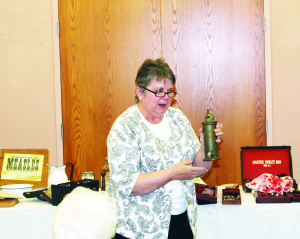|
Caledon Citizen https://caledoncitizen.com/medical-care-has-improved-since-the-victorian-era/ Export date: Fri Jun 6 23:27:14 2025 / +0000 GMT |
Medical care has improved since the Victorian eraBy Bill Rea Many might long for what's commonly known as “the good old days,” but stick with the present when it comes to the practise of medicine. The Caledon East and District Historical Society received a good lesson in that recently as Kitchener resident Nancy MacLeod brought her Victorian Medical Show to the area. A lot has changed from the days when doctors didn't even recognize the existence of germs. MacLeod explained a lot has changed in terms of attitude. For example, she said during the American Civil War, men who were too ill to fight were expected to help out in hospitals. The belief at the time was women shouldn't be taking care of men they were not related to. As well, in those days, it was expected that a doctor had to be a man. During 1800s, there were about 80 medical schools in North America. Some of them developed in to the prominent centres that still operate today. Others just required a certain amount of money for a doctor to receive certification. These schools offered two-year courses, MacLeod added. “It's all theory,” she said. “You really didn't get into the blood and guts of it until later on.” In the 19th century, the idea was people got sick because they had too much blood, or phlegm of bile. As far as children were concerned, it was the mothers who provided the first level of care if they fell ill. MacLeod said if a child was not feeling well, the first things the mother would prescribe were a bath and a bottle of wine. She explained that in those days, people might take a bath once a year, usually in May (she said one of the reasons why so many weddings are traditionally held in early June stems from the days when it would have been shortly after the brides had their annual baths). The reason behind the wine was it was thought it would make the blood stronger, which it didn't. She added there was no law in those days against giving children alcohol. If the child was still ill after the bath and wine, MacLeod said it would be time to call in a doctor. In those days, especially in rural areas, doctors would have been rather scarce, and would have had to cover a large area. That meant a doctor called in to treat a child would have had to stay at the house, until needed elsewhere by another patient. And since there was probably one bed in the house, with a mattress full of straw and fleas, they all would have slept on the same bed, fully clothed. Doctors, at the time, relied on equipment and practices that were available. For example, MacLeod said the way to check how a heart was working was for the doctor to lay his head on the patient's chest. That's one reason why they eventually invented the stethoscope. There were other pieces of equipment that were put to multiple uses. MacLeod had an example of an enema pump, which could also be used by women to address their feminine needs. And since no one believed in germs at the time, there was no need to sterilize it. She also had a sample of what was used as a bedpan in those days, and the simple way they'd deal with such issues. “When it's full, they'll open the window and empty it out,” she explained. There were medicinal powders, etc. in those days, which would have been mixed with water into a paste. Some of them would have included side effects, such as rotting of teeth, meaning they would have to be pulled. MacLeod had a sample of a devised used for such a purpose. She said some people have mistaken it for a wine bottle opener. Since it was assumed that some ill people might have bad blood, leaches would have been used to draw it out. MacLeod said they would have left saliva under the skin, which would have thinned the blood, so the patient would continue to bleed after the treatment. Or the doctor might have cut into a vein to draw the blood. MacLeod had samples of instruments with as many as 12 razor blades mounted on them for that purpose. The wounds would have been bandaged, and when they had healed, the bandages would have been washed, iron and rolled up to be used again. The advent of electricity resulted in devices coming into play to make use of it. MacLeod said there were items used by men because they were told it would help them grow hair. She also cited a Sears Roebuck catalog from 1908 advertising a home electric shock machine that sold for $12. She said it could be applied to the temples, hands or “to invigorate men.” “It's the only piece that's heavily used,” she added. |
|
Post date: 2015-11-18 15:41:52 Post date GMT: 2015-11-18 20:41:52 Post modified date: 2015-11-19 09:39:24 Post modified date GMT: 2015-11-19 14:39:24 |
|
Export date: Fri Jun 6 23:27:14 2025 / +0000 GMT This page was exported from Caledon Citizen [ https://caledoncitizen.com ] Export of Post and Page has been powered by [ Universal Post Manager ] plugin from www.ProfProjects.com |
